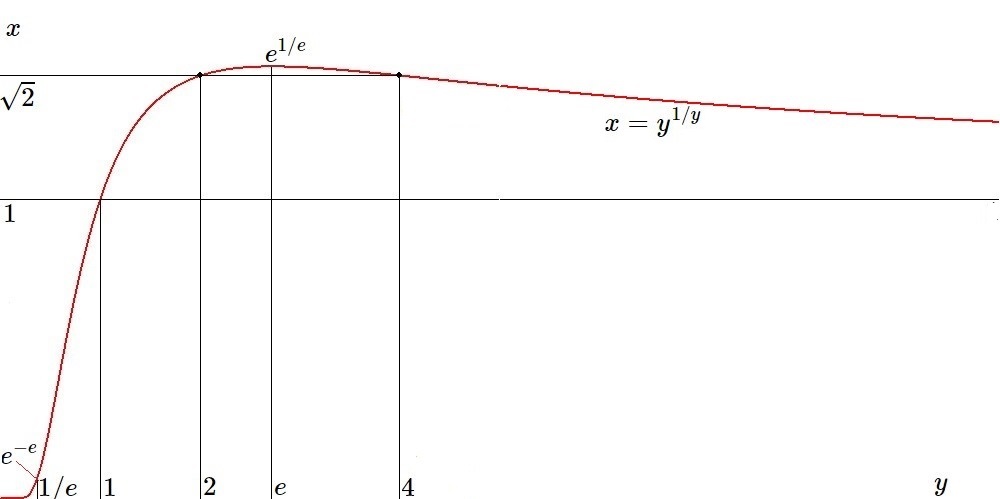
While the power tower itself is not defined outside the interval $e^{-e} \le x \le e^{1/e}$, the inverse function, when considered apart from the former, is defined, not only for $\,1/e \le y \le e\,$ but for a much larger domain, namely $\,0 \le y \lt \infty\,$. Details of function behaviour are described a great deal in the following MSE posting and its references:
It's easy to prove that $\,\lim_{y\to\infty} y^{1/y} = 1\,$. This means that $\,x = y^{1/y}\,$ has twofold solutions $\,y_{1,2}\,$ for $\,1 \lt x \lt e^{1/e}\,$, one $\,1 \lt y_1 \lt e\,$ and the other $\,e \lt y_2\,$, wich is anyway clear from the picture. Indeed the OP's solutions are among these: $\,1 \lt 2\lt e \lt 4\,$.program edit;Output:
function Newton(y12,x : double) : double; const eps : double = 1.e-9; var y : double; begin y := y12; while abs(exp(ln(y)/y)-x) > eps do y := y - (exp(ln(y)/y)-x) * sqr(y)/(exp(ln(y)/y)*(1-ln(y))); Newton := y; end;
procedure test; const x : array[0..8] of double = (1.4, 1.3, 1.2, 1.1, 1.05, 1.02, 1.01, 1.001, 1.0001); var y1,y2 : double; k : integer; begin y1 := 2; y2 := 4; for k := 0 to 8 do begin y1 := Newton(y1,x[k]); y2 := Newton(y2,x[k]); Writeln(x[k],' ==> (',y1,',',y2,')'); end; end;
begin test; end.
1.40000000000000E+0000 ==> ( 1.88666330624630E+0000, 4.41029279309327E+0000) 1.30000000000000E+0000 ==> ( 1.47098895928257E+0000, 7.85706535100170E+0000) 1.20000000000000E+0000 ==> ( 1.25773454121357E+0000, 1.47674583809828E+0001) 1.10000000000000E+0000 ==> ( 1.11178201104165E+0000, 3.82287327653121E+0001) 1.05000000000000E+0000 ==> ( 1.05270345488064E+0000, 9.28715283791938E+0001) 1.02000000000000E+0000 ==> ( 1.02041238660200E+0000, 2.85536314597273E+0002) 1.01000000000000E+0000 ==> ( 1.01010152374054E+0000, 6.51100334614211E+0002) 1.00100000000000E+0000 ==> ( 1.00100100150234E+0000, 9.12312634995737E+0003) 1.00010000000000E+0000 ==> ( 1.00010001000084E+0000, 1.16676997475209E+0005)It is seen that the $\,y_1\,$ values near $\,y=1\,$ are close to $\,x\,$. Which should not be surprising, because $1^{1/1}=1$ and $\,\left. dx/dy\right|_{y=1}=1\,$. But I have no decent estimate for the "far away" solutions $\,y_2\,$.